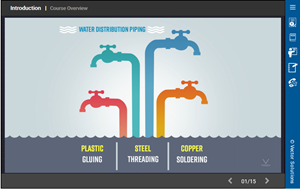
Plumbing: Pipe Fitting
Do you know the difference between a “street ell” and a “dielectric union”? A thorough understanding of plumbing systems is not possible without knowledge of the importance of fittings. While fittings are small and seldom seen, their importance cannot be overstated. Fittings provide the accessories to complete a plumbing system. Couplings allow multiple pipe sections to be connected. Elbows provide the mechanism for pipes to change direction. Unions are essential for easily disassembling plumbing systems for maintenance and repair. Plastic, steel and copper water piping systems will be covered, for waste systems plastic and cast-iron piping will be discussed. The unique connection methods for each piping material will be reviewed. While there are dozens of fittings available to the plumber only the most common ones will be presented including, couplings, elbows, unions, nipples and reducers. The cause of galvanic corrosion will be examined along with the fitting that prevents this type of corrosion. At the conclusion of this training you will be able to describe the connection method of various pipe materials and the tools and techniques required. You will be able to identify and describe a “street ell” and a “dielectric union”. You will become aware of troubling procedures for leaking unions. Finally, information on drain piping and the connection methods using “no-hub fittings will be presented.
Request a demoCourse Details
Learning Objectives
- Identify types of pipes and their applications in commercial buildings
- Name the tool used to cut threads on galvanized pipe
- Compare and contrast common types of fittings
- Identify a street elbow fitting
- Recall when galvanic corrosion occurs
Specs
| Course Level | Fundamental |
| Languages | English |
| Compatibility | Audio, Video, MobileReady |
Course Applies To
Demos + Pricing
Learn more about our courses, get pricing, and see our platform.











